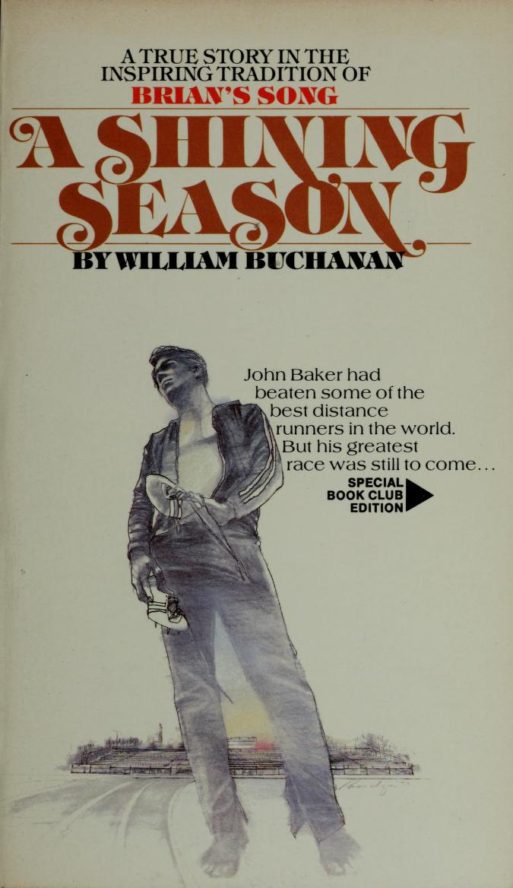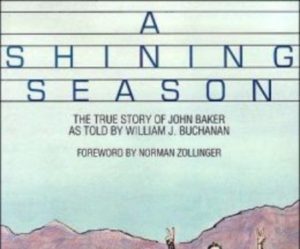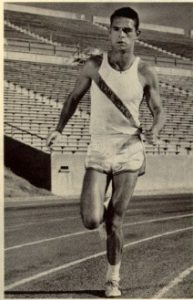 In “A Shining Season: The True Story of John Baker,” William Buchanan tells the story of what appears to be an overwhelming defeat turned into a triumph that no one could have predicted.
In “A Shining Season: The True Story of John Baker,” William Buchanan tells the story of what appears to be an overwhelming defeat turned into a triumph that no one could have predicted.
 In 1969, there were only a handful of runners who looked as if they had a chance at breaking the elusive four-minute mile. One of the most promising of these was John Baker of New Mexico. Baker also seemed to be a shoo-in for the next Olympic Games.
In 1969, there were only a handful of runners who looked as if they had a chance at breaking the elusive four-minute mile. One of the most promising of these was John Baker of New Mexico. Baker also seemed to be a shoo-in for the next Olympic Games.
Baker could have coached at any college he chose. But instead he took a coaching position at an elementary school not far from the home where he lived with his parents. He wanted to work with younger children and help get them excited about athletics.
But John Baker was struggling. No matter how hard he pushed himself, he couldn’t get his running times down. He was also having mysterious pains in his pelvis, abdomen and chest. One day, while running on a mesa, he experienced so much pain that he fell down. It took him nearly an hour to walk back to his car.
A long overdue appointment with the doctor confirmed his worst fears – testicular cancer that had spread throughout his body. Without treatment, his doctor told him, he would be dead in six months. Baker elected to try the treatment. He wanted as much time as he could possibly get.
Even so, after two harrowing surgeries to remove as much of the cancer as possible, Baker’s thoughts turned to suicide. One night, he drove his car to a high peak overlooking the school where he taught. But before he could accelerate, he flashed on a vision of the children crying for him and not understanding why he took his own life. He turned the car around and drove home. From that point on, Baker decided to spend whatever time he had left being the best coach he could possibly be.

Credit: jbes-aps-nm.schoolloop.com
“A Shining Season” follows John Baker through the last 18 months of his life. Baker’s philosophy was that every child could participate in athletics in some way. The ones who couldn’t play sports because of physical problems helped out with things like taking care of equipment and starting and timing races.
Baker rewarded the children for their efforts with elaborate ribbons he made himself. The children responded enthusiastically and almost all of them were proud to play some part in the athletic program.
Author William Buchanan never had a chance to meet John Baker in person. He got the material he needed for the book by interviewing John’s friends, family and medical team. Because John died in 1970, some of the aspects of his treatment described in “A Shining Season” are dated. For instance, John’s doctor advised him to keep his diagnosis hidden from his fiancée and to break up with her to spare her the grief his death would cause. Today, treatment teams work to fortify relationships and promote bereavement counseling to those left behind.

John Baker Elementary School
Credit: aps.edu
“A Shining Season” also portrays John as being in severe pain throughout most of his battle with cancer. Nowadays, hospice and palliative care teams have made great strides in managing pain so that patients last days are as peaceful and comfortable as possible.
In spite of its dated aspects, though, “A Shining Season” is truly inspirational. Baker could have committed suicide. He could have curled up in a corner and felt sorry for himself – who would have blamed him? Instead, he decided to do as much good as he could in the time he had left. After his death, the name of the school where he had worked was officially changed to the John Baker Elementary School at the request of the children he had coached.
“A Shining Season” does a great job of reminding the reader that a short life does not have to be a life without value. It is well-written, encouraging, and full of hope.

 “A Shining Season” by William Buchanan
“A Shining Season” by William Buchanan



 Trans Remembrance Project Provides a Community of Grieving
Trans Remembrance Project Provides a Community of Grieving
 Caring for a Dying Loved One? Be Gentle With Yourself.
Caring for a Dying Loved One? Be Gentle With Yourself.














